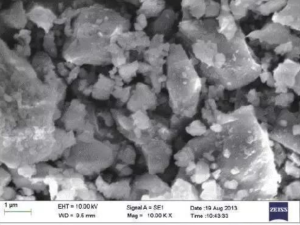1. Geometric features
Usually powder materials are used as fillers in granular form. The shape of the particles is not very regular, but for the performance of plastics, the geometry of the filler particles has an important influence on the physical and mechanical properties of the filling system, so the particle shape of the powder material is the first thing to pay attention to when using it.
For flaky particles, the concept of aspect ratio is often used, that is, the ratio of the plane size (longitudinal or transverse) of the flaky particles to the thickness; for fibrous particles, the concept of aspect ratio is often used, that is, the length of the fibrous ratio of diameters.

Most of the particle shapes of calcium carbonate are tetragonal, hexagonal, polygonal and irregular square particles, and its shape is very important in the plastic processing to the fluidity and the physical properties of the product.
2. Particle size
The important point of the filling modification technology is to disperse the powder particles into the plastic matrix evenly and one by one as much as possible, like the large and small islands in the sea, which is called the island structure. Generally speaking, the smaller the particle size of the filler particles, the better the mechanical properties of the filling system if they can be dispersed uniformly; but the smaller the particle size, the higher the processing cost, and the more difficult it is to achieve uniform dispersion. Therefore, it is very important to understand the particle size and distribution of powder particles and select them according to actual needs.
At present, there are many expressions for the particle size and distribution of powder particles. Before there is no unified naming method and regulations, the plastic industry often uses the mesh number method, that is, how many objects can the particles of the powder material pass through? The mesh number of the sieve indicates its particle size. In fact, the mesh number measured by this method refers to the largest size in the three-dimensional direction of the largest particle in the powder particles of this specification.
In plastic products, the narrower the particle size distribution of calcium powder is, the better, that is, the smallest particle size and the largest particle size are classified. Mechanical properties and oil absorption.
3. Specific surface area
The surface roughness of filler particles varies. That is, the surface area of particles of the same volume is not only related to the geometric shape of the particle (the spherical surface area is the smallest), but also to the roughness of its surface. The specific surface area is the surface area of the filler per unit mass, and its size is directly related to the affinity between the filler and the resin, the difficulty and cost of the filler surface activation treatment.
4. Surface free energy
The surface free energy of filler particles is related to the ease of dispersion of fillers in the matrix resin. When the specific surface area is constant, the surface free energy is large, the particles are easier to agglomerate with each other, and the more difficult to disperse. In the surface treatment of fillers, reducing its surface free energy is one of the main goals.
5. Density
The density of the filler is related to the packing state of the filler particles. Since the particles of light calcium carbonate are in the form of spindles, while the particles of heavy calcium carbonate are in the shape of broken stones, there are gaps between the particles when they are stacked, and the volume of the former is significantly larger than that of the latter. The apparent density is lower than that of heavy calcium carbonate, but this does not mean that light calcium is ‘light’ and heavy calcium is ‘heavy’, because the difference between them is very small in terms of their single particles, the former is 2.4 ~ 2.7g/cm3, the latter Which is 2.7 ~ 2.9g/cm3. In the field of plastic filling and modification, what really affects the overall density of the filling system is the density of the individual particles of the filler and their existing forms in the plastic matrix – whether they are agglomerated together, and whether there are voids between them and the matrix plastic molecules.
6. Oil absorption value
The amount of plasticizer dioctyl ester (DOP) that can be absorbed per unit mass of filler is called the oil absorption value. In plastic products using plasticizers, if the oil absorption value of the filler is high, the consumption of plasticizer will increase. The oil absorption value of the filler is related to the particle size and distribution of the filler and the structure of the particle surface. The oil absorption value of light calcium carbonate is often several times that of heavy calcium carbonate. Therefore, the use of heavy calcium can reduce the amount of plasticizer under the condition of achieving the same effect on resin plasticization. Generally, heavy calcium requires that the oil absorption value is less than 35mL/100g.
